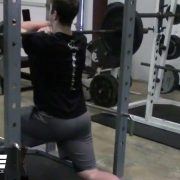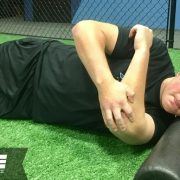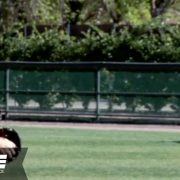Addressing And Correcting Trunk Tilt At Foot Strike
Many times, when analyzing video of our young pitchers, I’ll come across what I call trunk tilt at foot strike.
It’s quite common in younger throwers and is characterized by an excessive lean towards your glove side.
The head becomes tilted, facing away from the driveline and gives the appearance that the athlete is getting ready to launch the ball over a three-story building. This tilt helps to keep the arm at a roughly 90-110- degree angle from the body. It’s this angle that is thought of as being the safest and most powerful. Here are two examples of different positions at ball release, both with similar angles.
The problem could be lower-half driven (click here for a prior article on lack of back leg extension) or physical limitations in mobility or strength which we’ll be discussing today.
First, let me start by saying that pitching with an excessive contralateral trunk tilt has been associated with a benefit in velocity. This may be true, but it also has been associated with increased joint loading.
It’s true that many pro players can and do throw harder by creating more angular velocity and acceleration in the upper body from hand break to ball release through an excessive trunk tilt. If you’re currently making a great living playing pro ball then by all means carry on, but if you’re a young athlete trying to make it to the next level, the risk may not be worth the reward. Many times, correcting issues early on that can help address the tilt and learning to “re-tension” the throw may be just what keeps a young athlete in the game (injury free) long enough to get a shot at the big leagues, or even a great college education for that matter.
How To Identify An Excessive Tilt
Based on testing methods in the study, I use the side view of our 4-camera system to find the point when the pitcher reaches maximum shoulder external rotation at foot strike.
Being that our camera system is synchronized, I can now look at him from the front view at the exact same moment. Next, I’ll draw a vertical line straight up from the middle of the landing foot. If the middle of the head is more than a “head-width” outside of this vertical line, it would demonstrate what I call an “excessive contralateral tilt”.
The Effect Of Excessive Tilt On The Shoulder And Elbow
Since throwing with a tilt is essentially placing the arm slot in a more “over the top” position, there are higher levels of torque at the elbow and shoulder due to the arm moving in a more superior direction.
If you look at the picture below you can see that this athlete is about to accelerate his arm towards the plate.
Due to the degree of trunk tilt, his shoulder and elbow are going to be migrate in a more provocative, superior direction, which isn’t the greatest. Not a great direction for the shoulder or the labrum to be accepting force.
Keeping the body more upright will keep the direction of the throw moving in a more horizontal, less provocative (superior) direction.
What Causes An “Excessive Tilt At Foot Strike”?
It can be caused by a few different things but today, some of which are mechanical, but we’re going to talk about 3 big physical reasons that I see every day in our high school throwers.
We could include other issues such as hip mobility and t-spine extension as well, but for
the scope of this blog we’ll hit these three. Let’s dive a little deeper.
Poor Breathing Patterns
Next to the lower half, the rib cage is probably the most important part of a pitching delivery. It is at the center of the body, and serves as a platform for the shoulder blades to move upon.
Poor scapular movement can force the athlete to tilt the upper half to get to that optimum 90-110 degrees at foot strike that we talked about earlier. Working on breathing with the ribs down and shutting down tight lats can help upward rotation.
Anterior Core Strength
Many times, young athletes have an undeveloped and weak anterior core due to growing live in an extended posture.
This can inhibit rib cage and pelvic position, making it hard to create efficient rotation at front foot strike while still holding his line to home plate. The result can be a closed landing forcing an excessive tilt to help “cut the ball” around the body.
Creating some good rotational stiffness can go a long way.
Insufficient Lead Leg Strength
No mystery here. You can’t build a strong stabile house on a weak foundation.
Pitching coaches can try, try, try but if strength is the underlying issue they’re banging their heads against the wall. It just simply doesn’t work. Get strong.
If you’re looking to reduce your excessive lateral trunk lean, try focusing on your rib position, anterior core strength, and lead strength.
See ya’ in the gym…
Nunzio Signore
Latest posts by Nunzio Signore (see all)
- 4 Ways to Improve Your Command and Control in the Weight Room - November 13, 2018
- How to Use the Weight Room for Baseball Pitching Mechanical Issues - August 7, 2018
- Combining Strength Training And Throwing Programs For Baseball Pitchers - March 27, 2018















Is this contralateral tilt helpful or detrimental to pitching? Does it effect the arm or help?